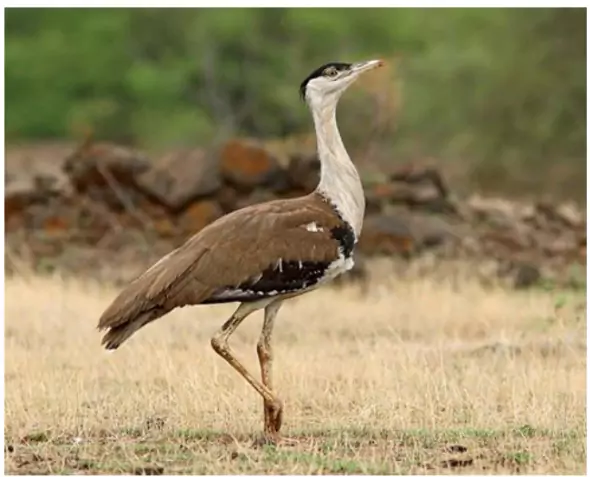A Supreme Court-appointed expert committee has proposed designated “power corridors” and revised priority conservation zones to reduce power line-related fatalities of the critically endangered Great Indian Bustard (GIB) in Rajasthan and Gujarat.
- Only ~150 GIBs remain, and their decline is linked to power lines, habitat loss, poaching, and predation.
Key Recommendations by the Committee
1. Designated Power Corridors: For overhead power lines in Rajasthan (5 km wide) and Gujarat (1–2 km wide) to minimise risk to Great Indian Bustards (GIBs) while allowing renewable energy development.
Classification of GIB Habitat
- Priority areas (regular GIB presence)
- Additional Important areas (seasonal use)
- Potential areas (possible future habitats)
- These zones were mapped using long-term field surveys and satellite tracking data collected by the Wildlife Institute of India and the Rajasthan Forest Department since 2014.
Focus areas in Rajasthan include
- Desert National Park
- Pokhran Field Firing Range
- Ramdevra buffer zone
- Dholiya, Khetolai, Salkha-Kuchri
|

2. Revised Priority Areas for GIB: Priority areas for GIBs increased to 14,013 sq km in Rajasthan and 740 sq km in Gujarat. These areas are now marked for focused protection and development restrictions.
3. Voltage-Based Power Line Management:
- Immediate undergrounding of select 33 kV lines
- No new power infrastructure in priority areas (solar >2 MW, wind turbines, overhead lines)
4. Proposed Conservation Measures:
- “Jump-start” method: Use of late-stage GIB eggs from Rajasthan for incubation by wild females in Gujarat.
- Tagging of all remaining GIBs in Gujarat to monitor movement and survival.
5. Dissent Note: One member dissented, demanding all 33 kV+ lines in revised areas be undergrounded or rerouted, warning that key habitats were excluded from protection despite known GIB presence.
About Great Indian Bustard (GIB)

- Scientific Name: Ardeotis nigriceps
- Status: One of the heaviest flying birds, Critically Endangered on the IUCN Red List
- Protection: Listed under Schedule I of the Wildlife (Protection) Act, 1972 and Appendix I of CITES
- Distribution: Found mainly in the Thar Desert of Rajasthan, with a total estimated population of just 100–150 individuals in India.
- Physical Features:
- Large bird with long, bare legs and a horizontal body, resembling an ostrich
- Notable black crown on a pale head and neck
- Body is brownish with wings marked in black, brown, and grey
- Both sexes are similar in size; largest birds weigh up to 15 kg
- Diet and Breeding: Omnivorous and opportunistic, feeding on seeds, insects (like beetles and grasshoppers), small rodents, and reptiles
- Breeds during the monsoon; female lays one egg on open ground
- Habitat: Prefers dry grasslands and scrublands for foraging and nesting.
- Lifespan: Around 12–15 years
Challenges in Conservation Of Great Indian Bustard
- Low Reproductive Rate: GIB lays only one egg per year on the ground, which is vulnerable to predators. The chick is raised for nearly two years, limiting population growth.
- Power Line Collisions: GIBs have poor frontal vision and large bodies, making them highly prone to hitting overhead wires.
Habitat Pressure: Expansion of agriculture, infrastructure, and grazing continues to degrade GIB’s grassland habitats, leaving little room for recovery.
Steps Taken for the Conservation of Great Indian Bustards (GIBs)
- Species Recovery Programme: GIB is part of the centrally sponsored Species Recovery Programme under the Development of Wildlife Habitats scheme.
- Bustard Recovery Project: Launched in 2016, planned by the Rajasthan government as well as the Environment Ministry.
- The Compensatory Afforestation Fund funded this project which consists of money collected for afforestation in lieu of diversion of forests for non-forest uses.
- Protected Areas Declared: Key habitats like Desert National Park (Rajasthan) and Naliya Grasslands (Lala Bustard Wildlife Sanctuary, Gujarat) designated as sanctuaries or national parks.
- Financial and Technical Support: Central government provides assistance to states for GIB conservation and protection measures.
- Conservation Breeding: Captive breeding centres established (e.g., Sam and Ramdevra in Rajasthan) to build a population for wild release and support in-situ conservation.
- Legal Protection: Listed in Schedule I of the Wildlife (Protection) Act, 1972, ensuring the highest level of protection and a ban on hunting.
- Conservation Breeding Centres (CBCs): Established in Ramdevra and Sorsan for long-term breeding and future rewilding of bustards.
![]() 28 Jul 2025
28 Jul 2025



